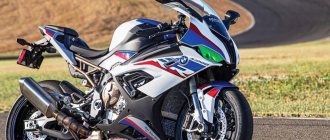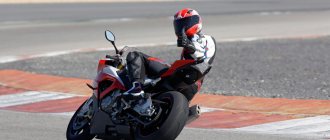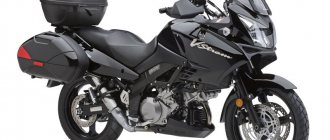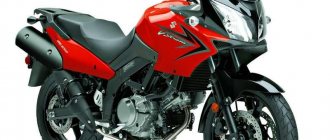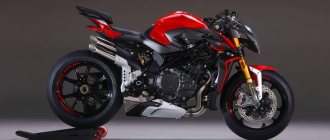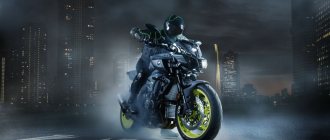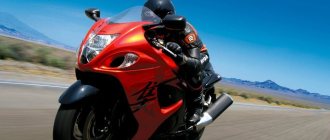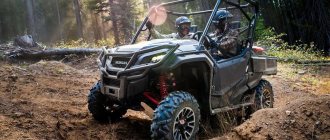“A touring sportbike” is how the guys from Munich describe the BMW S 1000 XR. And personally, I'm not going to argue: the XR has always been a stretched version of the S 1000 RR that can fit luggage, and this year the model is lighter, more powerful and more sophisticated than before. Having driven it for a few days, I can assure you that the XR is a powerful but quite sane beast that sits at the extreme end of the sport-touring class.
BMW S 1000 XR. Updates
Since its introduction in 2015, the BMW S 1000 XR has been based on the S 1000 RR hardware, and the 2022 model is no exception. It is equipped with an engine and many other aspects of the popular supersport.
Engine
The 999cc inline-four is lighter and more compact, and the BMW S 1000 XR features taller fourth, fifth and sixth gears for a more relaxed ride at cruising speeds. The complex and expensive Shiftcam used on the RR, which increases power at high speeds, seemed redundant here. However, the RR cutoff at 14500 is also not the most practical thing.
So the character of the BMW S 1000 XR engine was changed by equipping it with specially designed camshafts and an exhaust manifold , which moved the thrust from the top to the mid-range, which is very useful for normal road driving. But even so, the peak power of the BMW S 1000 XR, amounting to 165 horses (5 more than last year), is achieved at 11,000 rpm - a thousand below the cutoff. Peak torque of 114 Nm is achieved at 9250 rpm. Already at 3000, 81 Nm is available, but the engine clearly shares the torquey character of its sportier twin.
Chassis
Like the engine, the aluminum twin-spar frame is lighter and narrower, especially between the rider's knees. In keeping with the latest trends (notably the Kawasaki Ninja 1000SX), the stock tail section is equipped with mounts for 30-litre panniers, available as an accessory. Yes, it’s understandable - it’s easier to sell panniers for touring motorcycles when everything is already ready for them, and it’s good that motorcycle manufacturers have finally realized this.
A new pendulum is attached to the frame, to which the shock absorber is directly attached (meaning, without a lever). The suspension operation is controlled by the D-ESA (Dynamic Electronic Suspension Adjustment) system with its updated valves and firmware. The suspensions work quite well, thanks to the fact that the suspensions, both the fork and the rear monoshock, adjust stiffness on the fly up to 100 times per second, leveling the chassis and tenaciously holding on to the road, including during braking and acceleration. I’ll talk about this later, but for now I’ll just note that D-ESA is a really effective and functional feature.
BMW S 1000 XR 2020
Design
The headlights and face of the BMW S 1000 XR are finally symmetrical (who even thought of giving motorcycles a slightly stoned look?!), and the light in the headlights is emitted by diode lamps. The turn signals are also diode, and from the back everything looks as if the motorcycle does not have a tail light. Well, actually, there isn’t: this function is assigned to what looks like rear turn signals on legs.
I wonder if such a design generally meets the standards for brightness and visibility of lighting equipment? Americans are strict with rear lights; even additional brake lights on saddlebags are not allowed everywhere, although it would seem, what’s wrong?
Apart from the lighting technology, the BMW S 1000 XR is visually little different from the previous version, but the seating position has been moved forward a little, and the steering wheel is a couple of centimeters lower and about three centimeters narrower. BMW says the new stance improves weight distribution and front-wheel feel, while a narrower handlebar makes it easier to maneuver at low speeds.
The slightly updated body kit is supposedly more aerodynamic (7 percent less drag) and six decibels quieter than the previous model when the optional tall windshield is set to the up position. BMW seems to be implying that most motorcycles sold will be fully equipped (they claim 99.6 percent of motorcycles sold fully equipped). I don’t know if this is true, or just a way to hint to clients “don’t be like those 0.4 percent” - but in general, it seems to be true. Our example is fully equipped: bi-directional quickshifter, center stand, carbon trim, fog lights, keyless entry and a dozen other options.
Let's leave the options and talk about stock. For example, BMW redesigned the steering wheel mount to reduce vibrations (yay!), the dashboard is now decorated with a 6.5-inch TFT display with two modes, and they also added an inertia measurement device, thanks to which wheelie control with several degrees of sensitivity, as well as stoppies, is implemented -control and anti-lock braking system with tilt angle tracking (ABS Pro). In addition, engine braking control and hill assist have been implemented, and the riding modes have been expanded and improved.
And one more point, after which we will move on to the real review. This year's BMW S 1000 XR rides on the same alloy wheels as the RR, and they're a couple of kilograms lighter than last year's. We all know that the less rotating mass, the better for handling, but I'm talking about something else: according to the BMW website, last year's model weighed 228 kg, and this year's model weighs 226. At the presentation, they stated that they had reduced the weight of the existing components by 10 kg - and one wonders where another 8 come from. But apparently, the fact is that BMW decided to compare the weights of fully loaded motorcycles, and not the base models (remember about 99.6 percent?).
Thanks for your patience, let's get to the point: how's the new product doing?
Vibration
Anyone who has heard of the BMW S 1000 XR knows that the main problem with this model is vibration in the steering wheel. Higher gears and rubber steering wheel spacers reduce vibration to tolerable levels up to 6000 rpm (that's about 140 km/h in sixth), but things get worse on the right half of the tachometer. But you still won’t notice this, because at these speeds your pupils will already dilate, and your heart will try to catch up with the engine in terms of beat frequency.
Well, it turns out vibrations are no longer a problem. What's the problem?
Seat
Thin, too soft, strangely shaped - literally from the first minutes the seat of the BMW S 1000 XR somehow digs into the butt. And by the middle of a 20-liter tank (about 150 km at a consumption of 6 per hundred), the ass will ask for mercy. Worse, the passenger side is not suitable for driving at all - this was the unanimous opinion of the three passengers I tried to ride.
By happy coincidence, BMW offers a whole bunch of seat options as options, including an inflated and lowered one, which any normal dealer will replace with a stock one at no extra charge. But it is possible with an additional payment - there are several expensive options, but there are also simpler ones. The standard seat height is 84 cm, but the bike is narrow, so it’s quite comfortable with my 175.
Apart from the seat, everything about the fit is good. Upright, relaxed, without stress on the palms, excellent lever on the steering wheel - in short, a landing position in which you can ride all day. Well, by changing the seat, of course.
Body kit
For me, the stock windshield with two positions is ideal in the upper one - it creates a bubble of calm air. In the lower position of the windshield, the helmet flutters quite a bit, and I recommend that anyone who is taller than me take a high windshield, because when I stand up from behind the windshield in the upper position, the helmet literally 5 centimeters higher also begins to flutter.
The BMW S 1000 XR can be equipped with 90 liters of hard cases, loaded with something nice and compensated for rear shock preload at the touch of a button (or let the computer do it if you, like 99.6 percent, bought a D-ESA Pro). With a high windshield and a thick seat, you'll get an absolutely excellent sports tourer, especially considering the heated grips and cruise control up to (think about it) 185 km/h.
But let's be honest. For those who need long daily runs, the recipe has long been known: a little RT, GS or any other K series. And the BMW S 1000 XR is not for long roads. He only puts up with them when you go to those places where he is really good: to the serpentines. Or to the track.
BMW S 1000 XR 2020
BMW S 1000 XR - a sportbike at heart
On winding roads everything becomes correct and clear. The BMW S 1000 XR is in its place, you are in your place, and all sorts of protests, covids, quarantines are happening in the forest.
Or they dissolve in the clear morning air through which you glide, opening the gas and plunging into unity with the XR, which steers with the power of thought and stops with a gentle squeeze. This is one of those motorcycles that is so assembled and balanced, working so harmoniously and clearly, that it does not require anything from the rider. Except, perhaps, the desire to develop.
A slight pressure on the steering wheel shifts it from one side to the other, and in any turn, in any tilt, it easily allows you to adjust the trajectory, even by braking, even by opening the gas, without objections or steering. Thanks to D-ESA for this. Despite the rubber spacers in the steering wheel spacers, feedback from the road is excellent, and steering clarity is also excellent. There's no need to lean over to corner - the BMW S 1000 XR happily leans where you point with your chin or knee.
It dances between corners like a real sportbike, and when the road straightens out, it turns “there” into “here” with terrifying speed.
It has traction everywhere, but the traction starts in the second half of the range. And from 8500 to the cutoff of 12000, it accelerates simply frighteningly, and the engine roars as if it were a sportbike. It often sits up in first gear, and the engine easily exceeds the capabilities of the rear Bridgestone T31, but this is not for everyone.
The BMW S-series has always been equipped with excellent brakes, and the BMW S 1000 XR is no exception. Even with a conventional axial master cylinder, the brakes grab powerfully and apply great force. One finger is enough to tear off the rear wheel. Add a perfectly calibrated bidirectional quickshifter, excellent cornering clearance and a set of electronic assistants - adjustable traction control, ABS, etc. - and you get a sportbike that will be the envy of many soapboxes.
The BMW S 1000 XR seems to be designed for the road, but to tell the truth, you won’t get a taste of it until you take it to the track. And the only thing he will be missing there is more serious tires.
Electronics
Yes, the BMW S 1000 XR has a distinguished pedigree, but don’t underestimate this year’s innovations, in terms of electronic systems, and especially D-ESA and ABS.
Let's start with D-ESA , because, in my opinion, it is the most interesting. The function of this system seems obvious - the electronics in the fork and shock absorber constantly adjust the compression and rebound smoothing to the situation. D-ESA is a stock system with one smoothing mode - Road - and three levels of rear suspension spring preload: rider, rider with luggage and rider with passenger. Purchasing D-ESA Pro unlocks a firmer Dynamic mode and replaces preload level selection with an automatic function that uses a sag sensor to adjust the spring as load changes.
Personally, I liked the soft Road mode (considering that the XR's suspension is more hard than soft, and with my 85 kg in equipment, I am apparently lighter than the average rider). But no matter what mode the suspension is in, the electronics effectively monitor its travel and control stiffness, and the effect of this control is more pronounced than on previous versions. For example, despite a shorter wheelbase and more powerful engine, the 2022 BMW S 1000 XR is less prone to wheelies than outgoing models.
With D-ESA, you can brake powerfully in corners, and the fork becomes stiffer, preventing dive , and when the brake is released, the system tightens the fork rebound and compression of the rear shock absorber when the gas is opened, helping the chassis tenaciously hold the road and trajectory, which makes the motorcycle stable and predictable.
All this is supported by ABS with a bunch of settings and several levels of sensitivity. The sensitivity of the front and rear wheels, the distribution of braking force, the level of anti-stop and sensitivity to the angle of inclination are adjusted separately (BMW calls this option ABS Pro). You can also select default settings for each of the riding modes: Rain, Road and Dynamic, as well as set all parameters manually in Dynamic Pro mode. The driving modes themselves affect engine power, throttle response, traction and wheelie control, and other characteristics.
The abundance of settings and their influence on the behavior of the motorcycle are impressive, and you really appreciate the effectiveness of the on-board electronics both in the rain, when you need maximum stability and safety, and on the track, when you need maximum fury and impact, brakes to the floor with rear lift and even slide into a turn in supermoto style.
BMW S 1000 XR 2020
Cons of the BMW S 1000 XR
The electronic gas has a slight but distinct delay from the fully closed position, and in the first degrees of its opening the thrust is very soft, if not weak. At first you have to get used to it in order to move normally at low speeds and take your time to start, but over time your brain and hand adapt.
Oddly enough, the traction distribution of the BMW S 1000 XR is not ideal for the road. The top end is certainly impressive, but the torquey four isn't as torquey throughout the rest of the range as rivals with a flatter torque curve. Yes, few of its classmates compare with the XR on fast roads or on the track, but we are talking about a road bike.
As much as I like D-ESA, I resent the lack of manual suspension control like on the S 1000 RR. Two anti-aliasing modes and Dynamic for an additional fee - that’s all? It’s especially sad considering that this is just a software option, and all the hardware for its operation is installed in stock.
Segment
>>Looking at the photographs of the BMW S1000XR shown last fall in Milan, for a long time I could not decide on the exact positioning of the new model. On the one hand, the new product reveals the characteristic features of the touring models of the BMW Motorrad GS series, clearly hinting at the serious capabilities of the motorcycle in the field of long journeys on roads of varying quality.
On the other hand, the modest suspension travel, cast wheels and purely road Pirelli Diablo Rosso II tires clearly place the XR in the category of exclusively “asphalt” cars. The final confusion comes from a durable aluminum frame and a powerful power unit from the BMW S1000R roadster, which implies dynamic high-speed driving, and possibly even going to the race track.
It turns out that in one “shaker” the Bavarian bartenders tried to mix an outlandish cocktail that combines outstanding dynamics, sporty character, a high level of travel comfort and the possibility of full-fledged everyday use. Not finding a suitable name from the existing motorcycle classifications, BMW marketers came up with their own - Adventure Sport. According to the company, this term most clearly describes the unique combination of sports and touring capabilities, as well as the strong emotional character and appearance of the new S1000XR.
As is often the case with emotional purchases, it is the appearance of the motorcycle that can be the decisive factor in choosing a particular model. And here the German specialists worked 100%. The design of the BMW S1000XR, created by the young Andreas Martin, is based on the Flyline concept. The graceful lines of the front fairing subtly reference the GS family of motorcycles, while the multi-layered side panels clearly reflect the sporting DNA of the S1000RR.
Obviously, for the sake of the overall harmony of forms, the company’s designers abandoned even the asymmetrical optics that had already become familiar to S-series models, leaving only a vertical strip of LED daytime running lights as a bright accent on the “beak”. The rear part of the motorcycle also became a victim of the all-consuming grace, whose weightlessness and “transparency” do not fit well with such an essential element of a touring motorcycle as side panniers. However, the creators of the BMW S1000XR, on the contrary, claim that the feed (including the subframe) and the XR muffler were developed taking into account the possible installation of luggage containers.
The meticulousness with which numerous plastic claddings are fitted to each other is worthy of special mention. It is in such details that the concept of “premium class” is manifested. When trying to summarize the impressions of the appearance of the motorcycle, only the most flattering epithets come to mind.
If we ignore some external similarities with the Ducati Multistrada and a number of other representatives of the Adventure bike class, so zealously attributed to the new product by detractors, I dare to call the new BMW the most stylish crossover of recent years. In terms of elegance of lines and integrity of the image, only the Italians can compete with the Bavarian - the same Multistrada and stuck somewhere on the way to the MV Agusta Turismo Veloce series.
UNIVERSAL
The BMW S1000XR was truly a success! The motorcycle turned out to be not only attractive in appearance, technically perfect and extremely advanced in terms of electronics, but also surprisingly balanced. Impeccably executed and equipped, the new motorcycle turned out to be not quite what was expected. The Bavarians did not make a four-cylinder GS, as many people think, and not even a “lifted” one for the sake of the S1000R style.
At its core, the S1000XR is as close as possible to the Ducati Multistrada crossover. But on the road, the XR shows a much greater bias towards aggressive, technical driving and a slightly less predisposition to long trips. But all these are exclusively subjective assessments based on the experience and preferences of a particular person.
It is possible that the emphasis and preferences in using the S1000XR for each owner will shift in one direction or another. After close contact with the Bavarian novelty, you get the feeling that there are several different motorcycles under you at once. We've seen motorcycle manufacturers attempt to create multi-tasking models before - just think of the Honda Crossrunner or Kawasaki Versys.
However, BMW Motorrad coped with this task at a qualitatively different, impeccable level. Perhaps we are looking at the brightest representative of a relatively young class of motorcycles, which are faced with the task of combining as harmoniously as possible the seemingly most contradictory advantages and the ability to cope with a wide variety of tasks.
Tags
BMW Tests and Reviews Touring motorcycle
